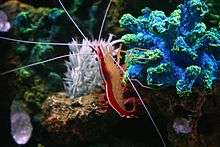Lysmata
| Lysmata | |
|---|---|
 | |
| Lysmata amboinensis | |
| Scientific classification | |
| Kingdom: | Animalia |
| Phylum: | Arthropoda |
| Subphylum: | Crustacea |
| Class: | Malacostraca |
| Order: | Decapoda |
| Infraorder: | Caridea |
| Family: | Hippolytidae |
| Genus: | Lysmata Risso, 1816 [1] |
| Type species | |
| Lysmata seticaudata (Risso, 1816) [2] | |
Lysmata is a genus of shrimp in the infraorder Caridea, the caridean shrimp. The genus now belongs to the family Hippolytidae, but recent cladistic analysis suggests it should be included in its former family, Lysmatidae.[3] Lysmata are popular ornamental shrimp in the marine aquarium trade for their bright color patterns, interesting behaviors, and ability to control certain aquarium pests[3] such as sea anemones of the genus Aiptasia.[4] They are known to command high prices on the pet market.[5]
The genus is informally divided into two main categories. Some species are cleaner shrimp which "clean" parasites and other material from fish, live in pairs, and are brightly colored, often in contrasting reds and yellows with white antennae. Other species are the "peppermint shrimp", which have semi-translucent, red-banded bodies, and live in large groups. Some peppermint shrimp perform cleaning behaviors, but less actively than do the cleaner shrimp.[4]
The genus has been studied with interest due to its unusual sexual system, protandric simultaneous hermaphroditism.[3] While some other taxa of shrimp undergo sequential hermaphroditism, they have only been observed changing from male to female. In Lysmata, males become true hermaphrodites instead of females.[6] So far, every species studied has been confirmed to have this sexual system.[7] During their "female phase" they actually have functioning male and female tissues in their gonads and produce both types of gamete. When paired, they take turns fertilizing each other's eggs.[6]
Lysmata occur in the tropics and in warmer temperate waters. They usually live on rock and coral reefs, in shallow and deeper areas. Some live in sponges.[7]
Species
Lysmata contains the following species:[8]
- Lysmata amboinensis (De Man, 1888)
- Lysmata anchisteus Chace, 1972
- Lysmata ankeri Rhyne & Lin, 2006
- Lysmata argentopunctata Wicksten, 2000
- Lysmata bahia Rhyne & Lin, 2006
- Lysmata boggessi Rhyne & Lin, 2006
- Lysmata californica (Stimpson, 1866)
- Lysmata chica Wicksten, 2000
- Lysmata debelius Bruce, 1983
- Lysmata dispar Hayashi, 2007
- Lysmata galapagensis Schmitt, 1924
- Lysmata grabhami (Gordon, 1935)
- Lysmata gracilirostris Wicksten, 2000
- Lysmata guamensis Anker & Cox, 2011
- Lysmata hochi Baeza & Anker, 2008
- Lysmata holthuisi Anker, Baeza & De Grave, 2009
- Lysmata intermedia (Kingsley, 1878)
- Lysmata jundalini Rhyne, Calado & Santos, 2012
- Lysmata kempi Chace, 1997
- Lysmata kuekenthali (De Man, 1902)
- Lysmata lipkei Okuno & Fiedler, 2011
- Lysmata moorei (Rathbun, 1901)
- Lysmata morelandi (Yaldwyn, 1971)
- Lysmata multiscissa (Nobili, 1904)
- Lysmata nayaritensis Wicksten, 2000
- Lysmata nilita P. F. R. Dohrn & Holthuis, 1950
- Lysmata olavoi Fransen, 1991
- Lysmata pederseni Rhyne & Lin, 2006
- Lysmata philippinensis Chace, 1997
- Lysmata porteri (Rathbun, 1907)
- Lysmata rafa Rhyne & Anker, 2007
- Lysmata rathbunae Chace, 1970
- Lysmata rauli Laubenheimer & Rhyne, 2010[Note 1]
- Lysmata seticaudata (Risso, 1816)
- Lysmata splendida Burukovsky, 2000
- Lysmata stenolepis Crosnier & Forest, 1973
- Lysmata ternatensis De Man, 1902
- Lysmata trisetacea (Heller, 1861)
- Lysmata udoi Baeza, Bolaños, Hernandez & López, 2009
- Lysmata uncicornis Holthuis & Maurin, 1952
- Lysmata vittata (Stimpson, 1860)
- Lysmata wurdemanni (Gibbes, 1850)
- Lysmata zacae Armstrong, 1941
Notes
- ↑ May also be considered a synonym of Lysmata vittata (Stimpson, 1860)[9]
References
- ↑ "Lysmata Risso, 1816". Integrated Taxonomic Information System. Retrieved October 7, 2013.
- ↑ J. Antonio Baeza (2010). "Molecular systematics of peppermint and cleaner shrimps: phylogeny and taxonomy of the genera Lysmata and Exhippolysmata (Crustacea: Caridea: Hippolytidae)". Zoological Journal of the Linnean Society. 160 (2): 254–265. doi:10.1111/j.1096-3642.2009.00605.x.
- 1 2 3 Andrew L. Rhyne, Ricardo Calado & Antonina Dos Santos (2012). "Lysmata jundalini, a new peppermint shrimp (Decapoda, Caridea, Hippolytidae) from the Western Atlantic" (PDF). Zootaxa. 3579: 71–79.
- 1 2 Andrew L. Rhyne & Junda Lin (2006). "A western Atlantic peppermint shrimp complex: redescription of Lysmata wurdemanni, description of four new species, and remarks on Lysmata rathbunae (Crustacea: Decapoda: Hippolytidae)" (PDF). Bulletin of Marine Science. 79 (1): 165–204.
- ↑ Ricardo Calado, Cátia Bartilotti, Luís Narciso & Antonina Dos Santos (2004). "Redescription of the larval stages of Lysmata seticaudata (Risso, 1816) (Crustacea, Decapoda, Hippolytidae) reared under laboratory conditions". Journal of Plankton Research. 26 (7): 737–752. doi:10.1093/plankt/fbh072.
- 1 2 G. Curt Fiedler (1998). "Functional, simultaneous hermaphroditism in female-phase Lysmata amboinensis (Decapoda: Caridea: Hippolytidae)" (PDF). Pacific Science. 52 (2): 161–169.
- 1 2 J. Antonio Baeza, Christoph D. Schubart, Petra Zillner, Soledad Fuents & Raymond T. Bauer (2009). "Molecular phylogeny of shrimps from the genus Lysmata (Caridea: Hippolytidae): the evolutionary origins of protandric simultaneous hermaphroditism and social monogamy" (PDF). Biological Journal of the Linnean Society. 96 (2): 415–424. doi:10.1111/j.1095-8312.2008.01133.x.
- ↑ M. Türkay (2012). "Lysmata Risso, 1816". World Register of Marine Species. Retrieved January 6, 2013.
- ↑ Guidomar Oliveira Soledade, Juan Antonio Baeza, Guisla Boehs, Sabrina Morilhas Simões, Patricia Souza Santos, Rogerio Caetano da Costa & Alexandre Oliveira Almeida (2013). "A precautionary tale when describing species in a world of invaders: morphology, coloration and genetics demonstrate that Lysmata rauli is not a new species endemic to Brazil but a junior synonym of the Indo-Pacific L. vittata". Journal of Crustacean Biology. 33 (1): 66–77. doi:10.1163/1937240X-00002122.
External links
 Data related to Lysmata at Wikispecies
Data related to Lysmata at Wikispecies